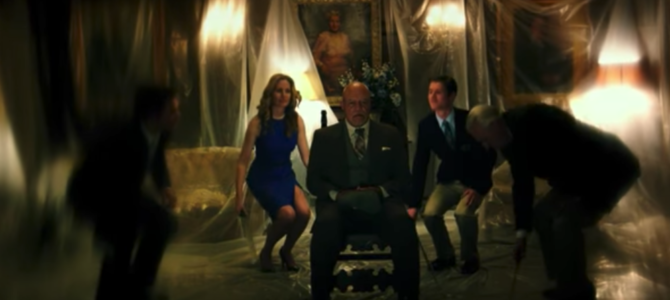
“The First Purge” is the fourth flick in a politically confused franchise that gets a few points for changing up its horror sub-genres each time out, even if this latest installment is the least satisfying.
Where 2013’s “The Purge” was a suburban home-invasion nightmare, 2014’s “The Purge: Anarchy” was an urban cross between “The Punisher” and “The Road Warrior,” and 2016’s “The Purge: Election Year” was a hyperviolent political thriller, “The First Purge” is an “N”-word festooned modern-day blaxploitation exercise complete with a good-at-heart drug kingpin (Y’lan Noel), his angelic activist girlfriend (Lex Scott Davis) and a sassy comic-relief auntie (Mugga). What’s missing is the visual style and what passed for cynical smarts from the previous three outings.
Here’s the plot. Elected amid economic and social turmoil, white right-wing religious racists known as the New Founding Fathers of America are about to conduct an experiment restricted to New York’s Staten Island: All crime, including murder, will be legal for 12 hours on one night. In what we know from the other movies will become an annual nationwide event, this so-called “Purge” is promoted as a way for citizens to cleanse and purify by venting all of their anger, aggression and otherwise anti-social impulses during that limited time. The government’s real purpose, which became explicit in “The Purge: Election Day,” is to weed out members of the underclasses by having them kill each other (with unofficial assistance as needed).
The premise is so inherently ridiculous that the three earlier movies played as a kind of absurd social satire. After all, how would survivors possibly go back to having normal “what happens on Purge night stays on Purge night” relations with each other the next day? And is it really likely that everyone instantly would stop shooting at each other the second the “time’s up” siren sounds?
Also, the movies invert reality by making religious conservatives the ones in favor of sanctioning punishment-free crime that makes the streets more dangerous. In California right now, Democrats are the ones who have supported legislation or propositions making thefts valued less than $950 misdemeanors, and who have reduced the number of crimes considered felonies. Democrats are the ones who have released prison inmates early by reclassifying transgressions including rape of an unconscious person, exploding a destructive device with intent to cause injury, assault with a deadly weapon and arson as “non-violent.” Left-wing lawmakers in the state even want to eliminate bail altogether, saying it is unfair to the poor, which would put everyone previously deemed bail-worthy back on the streets right away. If ever a place seemed intent on encouraging more rape, robbery and criminal brutality, it would be supermajority “progressive” Cali.
“The First Purge” also posits that most Staten Island residents who opt to stay there during the consequence-free Hell night would need outside encouragement to act upon their baser urges. Aside from the murderously psychotic junkie Skeletor (Rotimi Paul) and some drug-gang members with issues, nearly everyone else is content to hide in a church or dance at impromptu street parties until gangs of government-sanctioned mercenaries are sent in to increase the body count. In what has become a cliché of the franchise, even a character seeking perfectly justified vengeance upon a previous assailant decides not to go through with putting a bullet in him.
Granted, the residents we see — 99 percent of whom are black or otherwise “of color” — were enticed not to leave the island by a $5,000 government incentive. That means the stay-and-stick-it-out motivation for many was more monetary than murderous. Still, the idea that crime levels would not notably increase in already hazardous low-income neighborhoods if police disappeared overnight is one that Chicagoans might find amusing.
All four “Purge” installments have been written by James DeMonaco, who directed the previous three. Where the first was single-house claustrophobic, DeMonaco’s next two had a grittier, more color-saturated look and a wider scope. If “The First Purge” director Gerard McMurray intended to make this installment look cheaper and feel more generic, mission accomplished. One thing that does look good here: Some of the Purgers wear light-emitting “recording lenses” that act as video cameras, putting bright circles around the pupils of their eyes.
“The First Purge” unfortunately is missing the enjoyably indestructible main character from the last two movies, ex-LAPD Sgt. Leo Barnes (Frank Grillo), who went from Frank Castle-style loner in “The Purge: Anarchy” to head of security for an anti-Purge presidential candidate in “The Purge: Election Year.” Also MIA is three-timer Edwin Hodge, who played the rescued stranger in “The Purge” who became an anti-Purge resistance fighter in the next two movies.
After a half-hour of boys-and-girls-in-the-hood build-up, the plot here boils down to watching the Staten Islanders endure the increasingly lethal 7 p.m. to 7 a.m. shenanigans. They are remotely monitored by nasty government officials, who see thinning the herd as a good way to stop spending so much tax money on poor people. Psychologist Dr. Updale (played with a straight face by Marisa Tomei), the idealistic architect of the Purge, honestly believes that the experiment’s “freeing violence” will benefit society as a whole. Your basic banality of evil, in other words.
Although community do-gooder Nya (Davis) has split with drug lord Dmitri (Noel), the two join others including Nya’s kid brother Isaiah (Joivan Wade) to survive the night. The very out-of-place Auntie Dolores (Mugga) is along to make comic-relief comments about diarrhea and such. A final assault on an apartment building in the projects is a high-firepower extravaganza.
The movie’s creepiest image may be a glove that has several syringes attached to the back, with needles protruding menacingly. Bizarrely, however, we never see it put to use. Although that may be a good thing.
An unsubtle (but actually pretty funny) contemporary reference comes when Nya refers to a surprise crotch-clutcher as a “ “p—y-grabbing motherf–ker.” Even Trump might laugh at that one. Later, discussing the country’s rising debt, the ruling party notes that “we inherited all of this mess,” which sounds familiar.
If this franchise can’t come up with a smarter or more interesting premise next time around, this may be a good place to end it, since the series now has a cinematic beginning and finale. (“The Purge: Election Year” concluded with the government announcing an end to the program.)
But wait: An upcoming “Purge” TV series is promoted in a commercial that pops up in the end credits, which may be a first. Ammo up, citizens!









